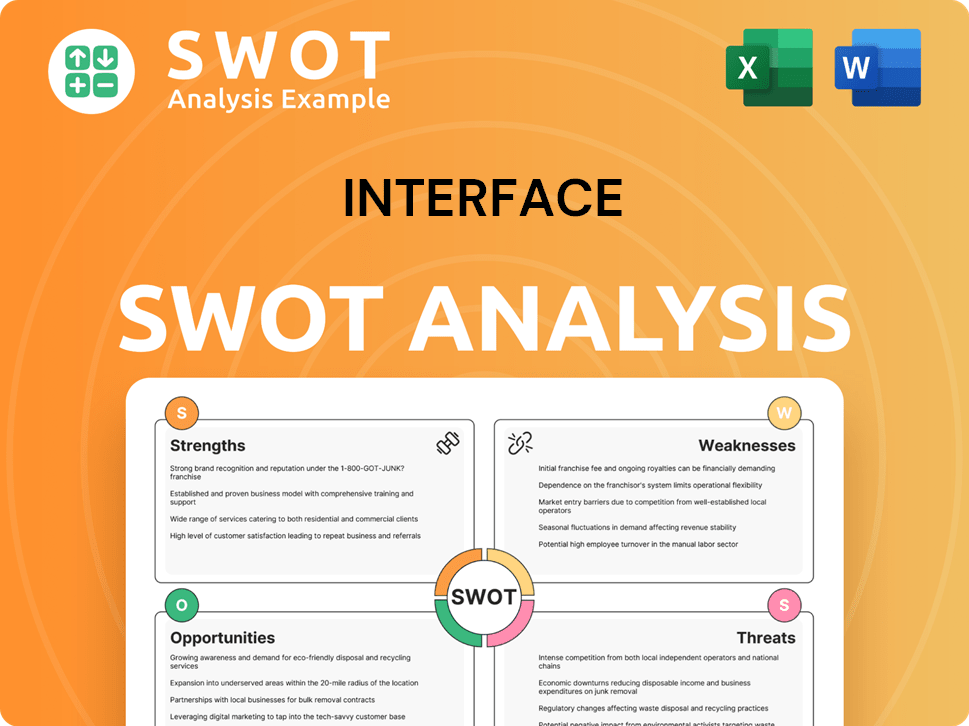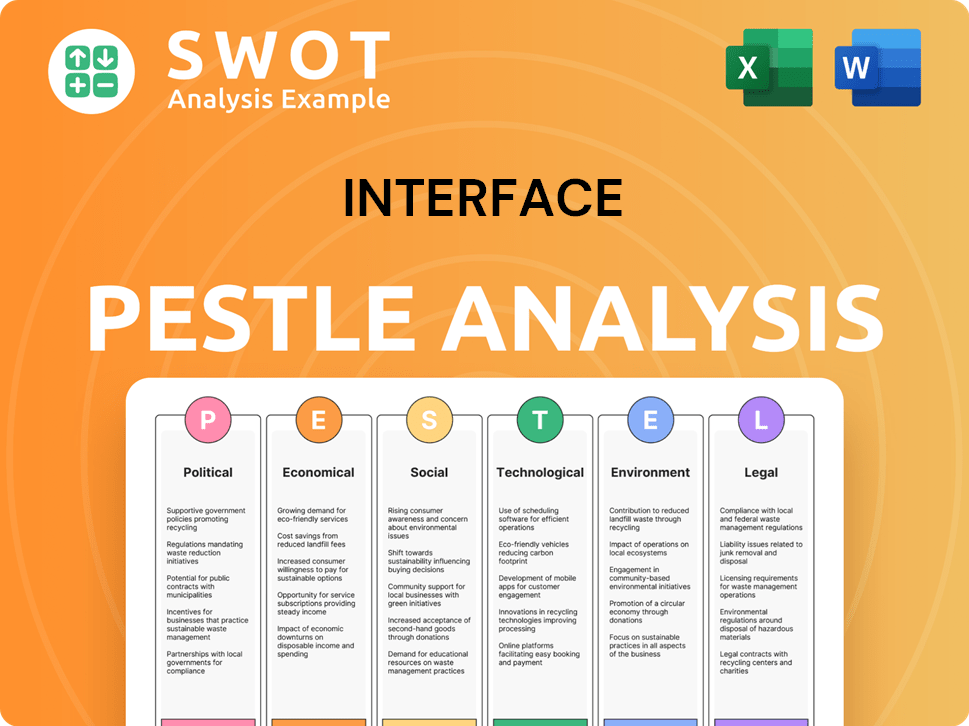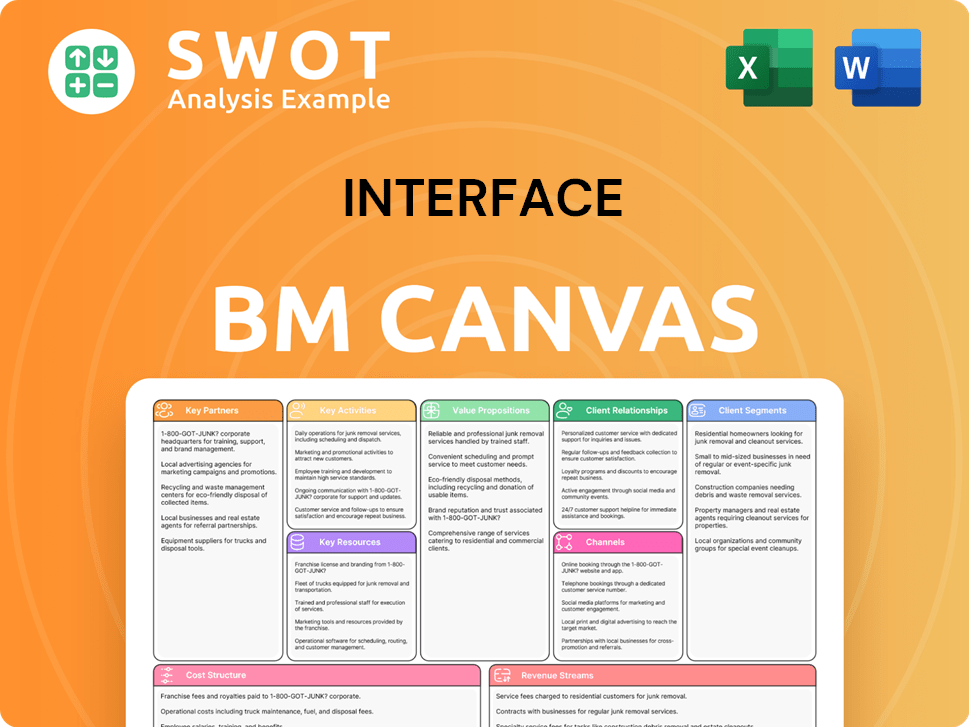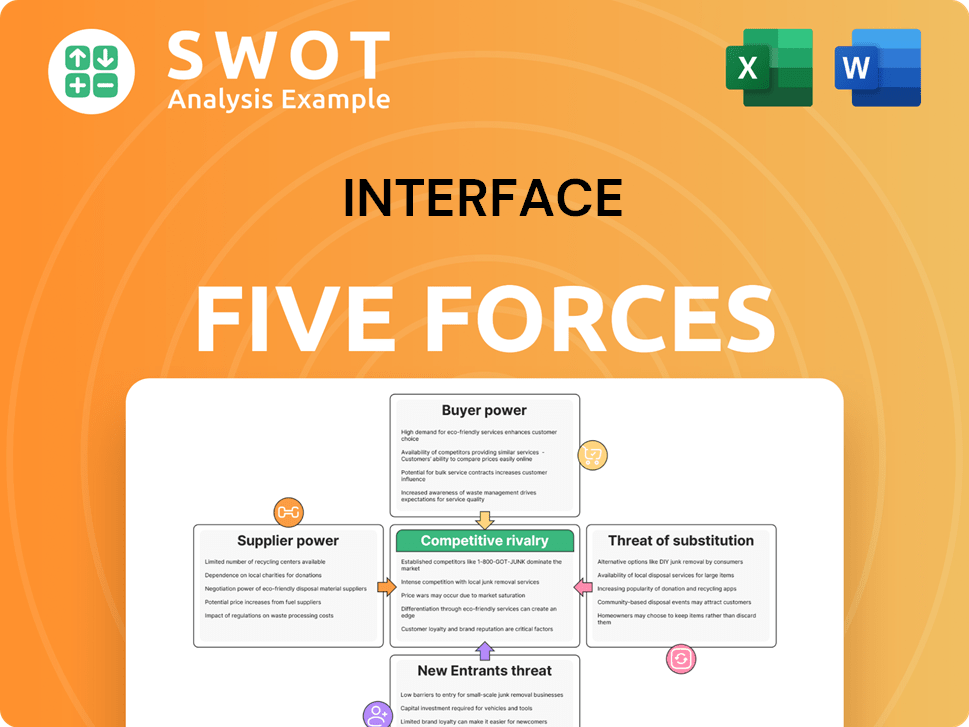Interface Bundle
How Does Interface Company Stack Up in Today's Market?
Interface, a pioneer in sustainable flooring, has transformed the industry with its innovative modular carpet tiles. Its commitment to environmental responsibility has not only set it apart but also reshaped the expectations of both competitors and consumers. This article dives deep into the Interface SWOT Analysis, exploring its competitive landscape.

As the Interface company competitive landscape evolves, understanding its position is crucial for anyone involved in the Interface industry trends. This analysis will identify key players in the Interface market competition, providing a detailed competitive analysis interface companies and highlighting the strategies that have allowed Interface to maintain and grow its market share interface. We'll also look at the challenges the company faces, including the impact of technology and shifting consumer demands, to provide a comprehensive Interface company analysis.
Where Does Interface’ Stand in the Current Market?
Interface holds a strong market position within the global flooring industry, especially in the commercial sector. The company is recognized as a leader in modular carpet tile. Its acquisition of nora systems in 2018 bolstered its presence in the rubber flooring segment.
The company's core offerings include modular carpet, luxury vinyl tile (LVT), and nora® rubber flooring. These products cater to diverse commercial spaces such as corporate offices, healthcare facilities, educational institutions, and hospitality venues. Interface also has a presence in select residential applications. Geographically, Interface operates globally, with sales and operations spanning North America, Europe, Asia, and Australia.
Interface has strategically shifted its focus to premium, sustainable offerings. This move allows the company to differentiate itself by prioritizing design, performance, and environmental attributes. This focus is crucial in today's market, where customers increasingly value sustainability.
While specific 2024-2025 global market share figures across all product lines aren't readily available, Interface is a key player in modular carpet tile. The acquisition of nora systems expanded its reach in rubber flooring. The company's strong position is further supported by its global presence and diverse product offerings.
In Q1 2024, Interface reported net sales of $295.6 million and a net income of $15.5 million. Although net sales decreased compared to Q1 2023, the company is actively managing its financial performance. This includes strategic adjustments to navigate market fluctuations and maintain profitability.
Interface is committed to sustainability, appealing to environmentally conscious customers. The company aims to reduce its Scope 1 and 2 emissions by 50% by 2030 from a 2019 baseline. This commitment is a key part of its market positioning and competitive strategy.
The Interface company competitive landscape is intense across all product categories. Competition is particularly strong in the LVT and traditional flooring markets. Understanding the Interface market competition is essential for strategic planning. For more insights, read about Owners & Shareholders of Interface.
Interface's market position is influenced by several factors, including product innovation, sustainability efforts, and global presence. The company's focus on premium offerings and environmental responsibility helps it stand out in a competitive market. The company's financial health and strategic decisions are also important.
- Strong presence in modular carpet tile.
- Expansion through the acquisition of nora systems.
- Commitment to sustainability and carbon reduction.
- Global operations and sales network.
Interface SWOT Analysis
- Complete SWOT Breakdown
- Fully Customizable
- Editable in Excel & Word
- Professional Formatting
- Investor-Ready Format

Who Are the Main Competitors Challenging Interface?
The competitive landscape for the flooring company, is multifaceted, encompassing a range of direct and indirect competitors. This analysis explores the key players and competitive dynamics within the modular carpet tile and luxury vinyl tile (LVT) markets, as well as the rubber flooring segment.
Understanding the competitive environment is crucial for strategic planning and market positioning. Factors such as product breadth, design innovation, sustainability, and distribution capabilities significantly influence the competitive dynamics. The following sections detail the major competitors and their strategies, providing insights into the challenges and opportunities facing the company.
In the modular carpet tile sector, the company faces significant competition from established global manufacturers. These competitors often have extensive product lines and global distribution networks, allowing them to compete on various fronts. The luxury vinyl tile (LVT) market presents a broader competitive landscape, with companies offering diverse designs and performance characteristics. Additionally, the rubber flooring segment has its own set of specialized competitors.
Key competitors in the modular carpet tile market include Tarkett, Milliken, and Shaw Industries. These companies compete on product breadth, design, and market share.
Tarkett is a global leader in flooring solutions, offering a wide range of products. They compete on product breadth and global distribution, with a strong presence in commercial and residential markets.
Milliken is known for its innovative textiles and flooring solutions, focusing on design and performance. They often target high-end commercial projects, competing on aesthetics and durability.
Shaw Industries, a subsidiary of Berkshire Hathaway, is a major flooring manufacturer. They offer extensive carpet, resilient, and hardwood options, leveraging their scale for competitive pricing and availability.
The LVT market includes a broader range of competitors, such as Mannington, Armstrong Flooring, and Mohawk Industries. These companies compete on design versatility and durability.
Mannington offers a comprehensive selection of commercial and residential flooring, including LVT. They compete on design versatility and durability, targeting diverse market segments.
The competitive landscape of the flooring company is dynamic, with various factors influencing market share and competitive positioning. To further understand the strategic moves of the company, consider reading about the Growth Strategy of Interface.
Several factors influence the competitive dynamics within the flooring industry. These include product innovation, sustainability efforts, and distribution networks.
- Product Innovation: Companies that introduce new designs and technologies gain a competitive edge.
- Sustainability: The demand for eco-friendly products is increasing, influencing market share.
- Distribution Networks: Extensive distribution capabilities are essential for reaching a wide customer base.
- Mergers and Acquisitions: These can significantly alter the competitive landscape by consolidating market share.
Interface PESTLE Analysis
- Covers All 6 PESTLE Categories
- No Research Needed – Save Hours of Work
- Built by Experts, Trusted by Consultants
- Instant Download, Ready to Use
- 100% Editable, Fully Customizable

What Gives Interface a Competitive Edge Over Its Rivals?
The competitive landscape for companies like Interface is shaped by a blend of innovation, sustainability, and brand strength. Understanding these elements is crucial for any competitive analysis. The company's approach to product design, its commitment to environmental sustainability, and its strong brand equity are key factors in its market position. Analyzing these aspects provides a clear view of its competitive advantages.
Key milestones and strategic moves have solidified Interface's position. The 'Mission Zero' initiative and the 'Climate Take Back' mission reflect a long-standing dedication to environmental stewardship. These efforts have led to the development of products with high recycled content and closed-loop manufacturing processes. These initiatives are essential for understanding the company's competitive edge in the market.
Interface's proprietary technologies and intellectual property further enhance its competitive position. Its modular carpet tile system offers flexibility and reduced waste. Continuous investment in research and development allows the company to introduce new product features. Brand equity and customer loyalty, built on decades of reliable performance and design leadership, are also significant strengths. For more insights, consider the Marketing Strategy of Interface.
Interface's commitment to sustainability is a primary competitive advantage. Their focus on eco-friendly building materials appeals to a growing market segment. The company's third-party verified Environmental Product Declarations (EPDs) provide transparency. This approach resonates with environmentally conscious clients, driving market share.
The modular carpet tile system offers significant advantages over traditional broadloom. The system's flexibility, ease of replacement, and reduced waste are key differentiators. Continuous investment in research and development allows for new product features and enhanced performance, maintaining a competitive edge.
Interface has built strong brand equity through decades of reliable product performance. Their design leadership and corporate responsibility contribute to customer loyalty. The company leverages these advantages in marketing by highlighting sustainability achievements and design expertise.
Interface faces challenges from competitors investing in their own sustainability initiatives. Shifts in industry standards could also impact their competitive advantage. However, their long-term dedication and established expertise provide a significant head start. These factors shape the overall competitive landscape.
Interface's competitive advantages include its commitment to sustainability, product innovation, and brand equity. The company's focus on eco-friendly building materials and modular carpet tile systems sets it apart. These advantages are reinforced by a strong brand reputation and customer loyalty.
- Sustainability: Products with high recycled content and low embodied carbon.
- Innovation: Modular carpet tile systems with flexible installation.
- Brand: Strong reputation for corporate responsibility and design.
- Market: Targeting environmentally conscious clients.
Interface Business Model Canvas
- Complete 9-Block Business Model Canvas
- Effortlessly Communicate Your Business Strategy
- Investor-Ready BMC Format
- 100% Editable and Customizable
- Clear and Structured Layout

What Industry Trends Are Reshaping Interface’s Competitive Landscape?
The global flooring industry is experiencing significant shifts that impact companies like Interface. Technological advancements and a growing demand for sustainable materials are key trends. These factors, combined with economic uncertainties, shape the Interface company competitive landscape, creating both opportunities and challenges for the company. Understanding these dynamics is crucial for strategic planning and market positioning.
Fluctuating raw material costs, supply chain issues, and intense competition, particularly in the LVT segment, present risks. However, Interface's focus on its 'Climate Take Back' mission and its commitment to lower carbon emissions by 2030 offer a strategic advantage. This positions the company well to capitalize on the growing demand for sustainable products, as discussed in Revenue Streams & Business Model of Interface. The ability to adapt to market shifts and invest in new technologies will be key to its future success.
Technological advancements are driving innovation in product development and customization. The demand for sustainable and healthy building materials continues to rise, fueled by environmental awareness and stricter regulations. The focus on indoor air quality and well-being in commercial spaces favors products designed to meet stringent emissions standards, providing opportunities within the Interface industry trends.
Fluctuating raw material costs, supply chain disruptions, and intense price competition, especially in the LVT segment, pose challenges. Economic uncertainties and geopolitical tensions can impact construction activity and consumer spending, potentially affecting demand for flooring products. Maintaining its premium positioning amidst increasing competition from more affordable sustainable alternatives is also a key challenge within the Interface market competition.
Expanding into emerging markets with increasing construction activity presents growth opportunities. Diversifying its product portfolio to meet evolving design preferences is another avenue for expansion. Strategic partnerships can enhance market reach and technological capabilities. The focus on the 'Climate Take Back' mission positions the company well for the growing demand for carbon-neutral and carbon-negative products, creating new Interface company analysis opportunities.
Interface's competitive advantage lies in its commitment to sustainability and innovative product design. Its ability to adapt to market shifts and invest in new technologies is crucial. The company must navigate challenges such as price competition and supply chain issues. The long-term success of Interface depends on its ability to maintain its premium brand image while offering competitive pricing and expanding its market share.
Several factors significantly impact the competitive analysis interface companies. These include the increasing demand for sustainable products, technological advancements in manufacturing, and fluctuating raw material costs. Understanding these elements is crucial for strategic decision-making and market positioning.
- Sustainability: The growing demand for eco-friendly products.
- Innovation: Technological advancements in product design and manufacturing.
- Market Dynamics: Economic uncertainties and geopolitical tensions.
- Competition: Intense price competition, especially in the LVT segment.
Interface Porter's Five Forces Analysis
- Covers All 5 Competitive Forces in Detail
- Structured for Consultants, Students, and Founders
- 100% Editable in Microsoft Word & Excel
- Instant Digital Download – Use Immediately
- Compatible with Mac & PC – Fully Unlocked

Related Blogs
- What are Mission Vision & Core Values of Interface Company?
- What is Growth Strategy and Future Prospects of Interface Company?
- How Does Interface Company Work?
- What is Sales and Marketing Strategy of Interface Company?
- What is Brief History of Interface Company?
- Who Owns Interface Company?
- What is Customer Demographics and Target Market of Interface Company?
Disclaimer
All information, articles, and product details provided on this website are for general informational and educational purposes only. We do not claim any ownership over, nor do we intend to infringe upon, any trademarks, copyrights, logos, brand names, or other intellectual property mentioned or depicted on this site. Such intellectual property remains the property of its respective owners, and any references here are made solely for identification or informational purposes, without implying any affiliation, endorsement, or partnership.
We make no representations or warranties, express or implied, regarding the accuracy, completeness, or suitability of any content or products presented. Nothing on this website should be construed as legal, tax, investment, financial, medical, or other professional advice. In addition, no part of this site—including articles or product references—constitutes a solicitation, recommendation, endorsement, advertisement, or offer to buy or sell any securities, franchises, or other financial instruments, particularly in jurisdictions where such activity would be unlawful.
All content is of a general nature and may not address the specific circumstances of any individual or entity. It is not a substitute for professional advice or services. Any actions you take based on the information provided here are strictly at your own risk. You accept full responsibility for any decisions or outcomes arising from your use of this website and agree to release us from any liability in connection with your use of, or reliance upon, the content or products found herein.